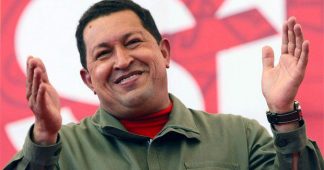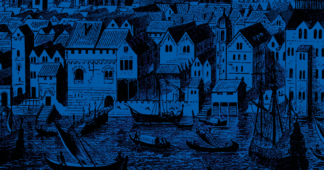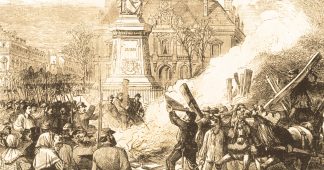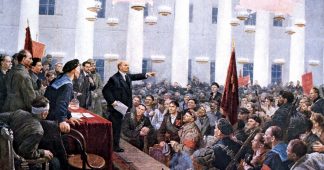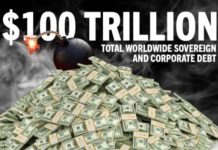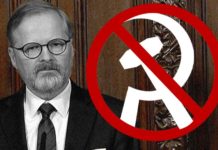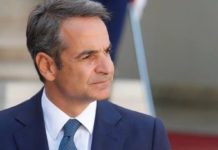This year marks the 90th Anniversary of the German Revolution of 1923. The tragic failure of this revolution marked a turning point and represented the end of the revolutionary wave that had swept Europe from 1917 onwards. It is no exaggeration to say that the consequences of the failure of the 1923 revolution determined the fate of Europe. A victory for the working class in Germany would have prepared the way for the European socialist revolution and would have changed the course of world history.
By Jul 23, 2013
We are now witnessing the deepest crisis of capitalism since the 1930s and once again a move towards a pre-revolutionary situation in Europe. Although this will be a protracted process, it is nevertheless essential for socialists to learn the lessons of the failed German revolution of 1923.
The stormy period of revolution
“It is indispensable for the entire party”, wrote Trotsky in 1924, “and especially its younger generations, to study and assimilate step by step the experience of October, which provided the supreme, incontestable, and irrevocable test of the past and opened wide the gates to the future. The German lesson of last year is not only a serious reminder but also a dire warning.” (Lessons of October)
1917 opened up a stormy period of revolution and counter-revolution. Lloyd George astutely said in 1919 that “the whole of Europe is filled with the spirit of revolution”, as mutinies broke out in the British armed forces. “Every day the situation grows worse”, stated the New York Times, “until many people are ready to declare that the United States will be the next victim of this dangerous malady.”
The old tsarist empire had collapsed and the workers and peasants had taken power in Russia; the Allies had invaded to crush the revolution, but were driven out and the counter-revolutionary Whites defeated. The German revolution of 1918 had overthrown the monarchy and soviets had been thrown up throughout Germany, but the revolution had been betrayed by the Social Democratic leaders, who assisted in the murder of Karl Liebknecht and Rosa Luxemburg, the greatest leaders of the German proletariat. A short-lived Soviet republic had been declared in Bavaria and Hungary; there were revolutionary factory occupations in Italy. The strike on the Clyde in 1919 was described by Robert Munro, Secretary of State for Scotland, as “not a strike but a Bolshevist rising”; even the British TUC and Labour Party had threatened a general strike in 1920 over munitions for Poland.
In Germany, the workers had defeated a military coup in 1920, which had led to a massive radicalisation. In October of the same year at its Halle Congress, the Independent Social Democratic Party, which had grown to 800,000 members and had 54 daily newspapers, debated its proposed affiliation to the Communist International (CI). A big majority voted to join the International and fuse with the small Communist party, while a minority split away. This event resulted in the formation in Germany of a mass Communist party of 500,000 members. It was the biggest Communist party outside of the Soviet Union. On this basis, the German revolution seemed assured.
The leaders of the Communist party, it is true, were deeply influenced by ultra-leftism and adventurism. They lacked the theoretical training of the Bolsheviks under Lenin and Trotsky. Their first major mistake in Germany was in March 1921, when the party led a failed general strike and insurrection as a “spark” to artificially break the isolation of the Russian revolution. This “theory of the offensive” led to massive victimisations and repression, resulting in the loss of two-thirds of the party’s membership.
The United Front
Lenin and Trotsky, who put forward the need for a united front policy at the Congress of the CI, condemned this debacle. They described themselves as on the “right-wing”, against the ultra-leftism of Bela Kun, Radek, Zinoviev and Bukharin. They argued that before the conquest of power, it was first of all necessary to conquer the working class by propaganda.
The idea of the united front meant that the CP would turn towards the reformist workers by offering joint action with their mass parties. There were to be no mixing of banners, no mixing of programmes, but a practical plan of action. Their motto was “march separately, but strike together!” In this way, the ranks of the CP could draw close to the mass of workers. In the end, this argument won the day.
Lenin wrote his book “Left Wing Communism, an Infantile Disorder” in order to combat these ultra-left tendencies and to educate the ranks of the Communist International. In this period, mass splits in the old Social Democratic parties had produced mass CPs not only in Germany, but also in France, Italy and Czechoslovakia. In 1921, insurrection was not on the agenda and the CI needed a new orientation. Thus the united front policy was born.
Through this work, the German party was able to rebuild its membership and influence throughout 1922. A new leadership was imposed by Zinoviev, the president of the Communist International, headed by Brandler. Paul Levy, who was chairman of the CP, had correctly criticised the “March Action” as the “biggest Bakuninist putsch in history”, but had broken party discipline over the issue and was expelled. He had been an able leader and Lenin has said that “The man has lost his head entirely … He, at least, had something to lose: one can’t even say that about the others.” In effect, while he made mistakes, he had been made a scapegoat.
The new German leadership wholehearted embraced the united front work. As a result, the resolute turn towards work in the reformist trade unions began to bear fruit in a period of the revival of strikes. 1922 was dominated by the rebirth of factory councils, in which the CP gained real influence. The damage of 1921 was being repaired. By the autumn, several thousand factory councils held a national conference, where the CP gained enormously. By the end of 1922, the Communist Youth had grown to 30,000 members. The party had 38 daily newspapers.
Transitional demands
Meanwhile, inflation began to soar. In November, the price of meat eggs and margarine doubled, while bread and butter trebled.
The party had put forward a series of transitional demands to draw the working class behind its banner:
- Supply of foodstuffs at cheap rates to property-less people.
- Requisition of empty or under-occupied residences for the benefit of badly-housed families of workers.
- Reduction of the working day to eight hours.
- Obligation upon all between the ages of 18 and 58 to work.
- Amnesty for political prisoners, except counter-revolutionaries.
- Dissolution of the strike-breaking organisations.
- Organisation of workers’ self-defence.
- Struggle against reaction, beginning with a purge of the administration.
- Obligation on the Landtag to endorse the decisions voted by the Saxon Congress of Factory Councils.
- Joint national campaign for a workers’ government of the Reich.
This policy meant that the party members would march at the head of everyday struggles of the workers, linking the day-to-day issues with the need for a workers’ government. The party leaders adapted themselves to this new propaganda phase, which they believed would last for a very long period of time. Clearly, there was a risk of opportunism implicit in the tactic of the united front, i.e., an adaption to the practical day-to-day problems and losing sight of the conquest of power.
Sharp turns
This routine was sharply broken with an abrupt turn in the objective situation, forcing a complete revision of their past perspective. The national government in Berlin faced a deep crisis over reparations imposed on German by the Versailles Treaty. They pleaded for a moratorium on reparations but this was refused by the French. Berlin tried continual devaluation of the German currency, the mark, to lighten the financial burden but this simply added to the crisis. Eventually, the government failed to meet its commitments and defaulted on reparation payments in January 1923. This was immediately met with the occupation of the Ruhr by French and Belgian troops on the pretext of “seizing a productive security”. The Ruhr was Germany’s industrial heartland where 80% of its steel and 71% of its coal production was concentrated.
Events escalated rapidly. A day after the troops arrived, the Cuno government in Berlin announced a policy of “passive resistance” to the occupation and forbade the payment of reparations. Spontaneous strikes broke out which were viciously attacked by the French occupying forces. By the end of January the government had imposed martial law in the face of a growing paralysis. They reverted to expelling 1,400 German rail workers from the Ruhr, while drafting in French and Belgium replacements. This was like pouring petrol on the fire as the conflict turned to violence.
Rail lines were torn up and electricity and phone cables were ripped out. Sabotage became widespread which served to paralyse transport and industry.
The bosses government sought to control the resistance movement by directing it on nationalist lines, including the use of the fascist Free Corps. The SPD leaders joined a united front with German bosses, but this soon began to break down.
The German ruling class was becoming fearful of the situation and was now prepared to collaborate with the French state to prevent anarchy and revolution. On 26 May, a senior German official, Dr Lutterbeck, wrote to the French General Denvignes, to ask him to give authority to German police to enter the occupied zone to restore order:
“This danger hangs over the world. If the French High Command stands idly by, waiting inactively for the rioting to break out before responding, it will give you the impression that France desires that German authority shall collapse… even at the cost of an uprising which would threaten European civilisation by placing the Ruhr in the hands of the populace. The game is dangerous to France itself. The army of occupation does not consist only of inanimate material, rifles, machine-guns and tanks. Men who have eyes and ears carry these weapons. They risk taking from the Ruhr dangerous seeds which will germinate in French territory.
“In the presence of these dangers, I take the liberty of emphasising the heavy responsibilities which the French High Command would incur if it showed itself to be indulgent towards anarchy. If it does not itself act, its duty is at least to leave the hands of the German authorities free to accomplish theirs… I take the liberty of recalling in this connection that at the time of the Paris Commune, the German Command did all it could to meet the needs of the French authorities taking repressive action.”
This shows clearly the cold-blooded class solidarity of the ruling classes in the face of socialist revolution. When their class interests are threatened, they are prepared to abandon all pretence of “national unity”.
Economic collapse and inflation
The occupation and the resistance plunged the economy over a cliff. As hyper-inflation took off, large sections of the working class and the middle class were reduced to pauperism. All forms of social security collapsed. There was no safety net. Devaluation of the mark was always used as a government policy to encourage exports and production. Runaway inflation would serve to wipe out government debt, but it also served to introduce the poison of inflation into the system.
In April 1922, the dollar was worth 1,000 marks; in October, 2,000; and in November, 6,000. On 4 January 1923, it was quoted at 8,000, on the 10th at 10,000 and on the 15th at 56,000. By 17 May 1923, the dollar was worth 96,000 marks, and on 10 July, 200,000. On 23 July, the dollar stood at 400,000, and on 28 July at one million. On 7 August, it went past two million; on 9 August, 6.5 million; on 5 September, just over 20 million; on 6 September 46 million, and on 7 September, 60 million. On 20 September, the dollar was worth 325 million marks.
The printing presses worked continuously, jumping from issuing one, two, five and 10 million mark notes, to 50 and 100 million notes. Shops put up prices from day to day, and then from hour to hour, adding zeros to marked prices. Workers had to spend their wages, taken in wheel barrows, immediately or lose everything.
Soon the peasants refused to sell crops. Shops were empty and markets deserted. Workers organised raids to obtain food. In July 1923, the average pensioner received 10,800 marks, which allowed him to make two tram journeys – provided they were made on the same day. Homelessness and unemployment grew and suicides reached record levels.
Growth of the Communists
The trade unions collapsed as their income evaporated. “At no moment were revolutionary aspirations so deep as in Germany during the summer of 1923”, wrote Arthur Rosenberg. The workers streamed towards the Communist Party.
At the enlarged ECCI meeting in June, Jakob Walcher estimated that over 2.4 million workers were under the authority of the Communists in the trade unions. The Communist Youth had more than doubled. In Bremen, party membership had doubled. In important places, like Stuttgart, Halle, Merseburg, Jena, Suhl, Sollingen, Remscheid, etc., the Communists had won a majority of 260,000 members of the metalworkers’ union.
The factory councils mushroomed, and became the basis of a new workers’ government, as the soviets had become in Russia. “The works committees are already taking part in Germany in settling such vital questions as food distribution, pay, fuel and arming of the workers”, explained Zinoviev. “They are becoming the principal lever of the revolution which is ripening before our eyes.”
The party took the initiative to establish armed groups – the Proletarian Hundreds. Within a few weeks, the movement spread throughout Germany, and in Berlin on 1 May, the procession was led by the Proletarian Hundreds, 2,000 men with red armbands, a genuine workers’ militia.
The political situation was becoming increasingly polarised. The fascists began to raise their heads, following in the footsteps of the Free Corps, the reactionary army officers and the declassed dregs of society. The fascists made progress, especially in the south. Hitler’s party, the National Socialist Workers Party, numbered 50,000 with the SA armed to the teeth. They wanted to copy Mussolini in Italy, who had seized power the previous year. However, their base was in the de-classed human dust and the ruined petty-bourgeoisie who had been driven mad by the economic chaos. They would be no match for a mass revolutionary movement of the working class that would draw behind it layers of the middle class. The question of leadership was decisive.
The question of power
However, the leaders of the International prevaricated and this percolated down. At the end of June 1923, the German CP was convinced that revolution was approaching. However, at the ECCI in June, no one posed the conquest of power in Germany as an immediate task. Zinoviev declared: “Germany is on the eve of revolution. This does not mean that revolution will come in a month or in a year. Perhaps much more time will be required.”
By July, the Cuno government was on the brink of collapse. The German CP issued a call for an “Anti-Fascist Day” throughout Germany on 29 July. It was an attempt to test the strength of the party on the streets. The bourgeois press denounced it as preparation for civil war. The Reich government called on all states to ban the demonstrations. All agreed accept Saxony and Thuringia, which the left controlled.
Brandler referred the issue to the EECI for clarification. Lenin was gravely ill; Zinoviev, Trotsky and Bukharin were away. Only Radek and Kuusinen were at the ECCI. Radek warned of the dangers of “forcing the struggle” and of “running to meet a defeat like that of July 1917”. He consulted Trotsky, who refused to express an opinion because of a lack of information. Zinoviev and Bukharin thought the party should defy the ban. Stalin’s opinion was the complete opposite. He wrote a private letter to Bukharin and Zinoviev:
“Should the Communists at the present stage try to seize power without the Social Democrats? Are they sufficiently ripe for that? That, in my opinion, is the question. When we seized power, we had in Russia such resources in reserve as (a) the promise of bread; (b) the slogan: the land to the peasants; (c) the support of the great majority of the working class; and (d) the sympathy of the peasantry. At the moment the German Communists have nothing of the kind. They have of course a Soviet country as neighbour, which we did not have; but what can we offer them? Should the government in Germany topple over now, in a manner of speaking, and the Communists were to seize hold of it, they would end up in a crash. That, in the ‘best’ case. Whilst at worst, they will be smashed to smithereens and throw away back. The whole point is not that Brandler wants to ‘educate the masses’. But that the bourgeoisie plus the right-wing Social Democrats are bound to turn such lessons – the demonstration – into a general battle (at present all the odds are on their side) and exterminate them [the German Communists]
“Of course, the fascists are not asleep; but it is to our advantage to let them attack first; that will rally the entire working class around the Communists (Germany is not Bulgaria). Besides, all our information indicates that in Germany fascism is weak. In my opinion, the Germans should be restrained and not spurred on.”
At this time, Stalin was in a secret faction, the Troika, with Zinoviev and Kamenev against Trotsky. With Lenin very ill, they did not want Trotsky to become the head of the party. This attempt to isolate Trotsky had terrible consequences and helped to consolidate power in Stalin’s hands.
Radek telegraphed Brandler to abandon the street demonstrations. Instead, indoor meetings were held, which attracted mass attendances.
By early August, when the situation was acute, Brandler, taking note of the messages from Moscow, stated that the task of the party was to prepare for a “defensive revolutionary struggle.”
Eventually, the Cuno government was forced to resign as mass strikes further paralysed the situation. Gustav Stresemann of the National People’s Party formed a coalition government, including four SPD ministers. This was a government of crisis and such tensions could not last for long.
The possibility of insurrection
An extended Russian Politburo met on 23 August to discuss the crisis. After a report by Radek, Trotsky intervened arguing for the date to be set for an insurrection.
Zinoviev concurred, but looked for a longer timescale. Stalin was sceptical, saying victory may be possible in the spring of 1924. It was agreed to convene a meeting in Moscow at the beginning of September with the German leadership.
Brandler, while paying lip-service to insurrection, was clearly held back for fear of a repeat of the March Action. He specifically disagreed with Trotsky on fixing a date for the insurrection. Radek supported Brandler.
On 23 September, Trotsky wrote an article, entitled “Can a Counter-revolution or a Revolution be Made on Schedule?” in which he declared that the sole duty of the party was “to fix a definite time in the immediate future, a time in the course of which the favourable revolutionary situation cannot abruptly react against us, and then to concentrate every effort on the preparation of the blow, to subordinate the entire policy and organisation to the military object in view, so that this blow is dealt with maximum power.”
Brandler refused to name the date and wanted to leave the issue open. He did, however, ask for Trotsky to be sent to Germany to lead the decisive battle, but that was opposed by Zinoviev, who represented the Troika, and did not want Trotsky to take any glory.
Technical preparations for insurrection were nevertheless undertaken by the Politico-Military Organisation. The party was put on a war footing.
In the meantime, Stresemann called off the campaign of passive resistance. Things seemed to stabilise. The dollar fell to about 100 million to the mark. A coup took place in Bavaria installing martial law. Ebert then declared martial law throughout Germany. The CP prepared a general strike and action committees.
In Moscow, a decision was taken that CP representatives would enter the left governments in Saxony and Thuringia. General Muller announced he was assuming power in Saxony and moved to ban the Hundreds. His orders were openly defied. The central government prepared to invade. The date of the counter-revolution was fixed. The Saxony workers appealed for support nationally. It was now or never.
It was decided to launch the call for a general strike from a conference of Factory Councils in Chemnitz on 22 October. After an appeal from Brandler, the Social Democrats wavered, raising all kinds of difficulties. If the Communists pressed the resolution, the SDP leaders threatened to walk out. The entire plan was blocked.
The CP members were completely disorientated and there was no alternative plan. The conference was a fiasco.
Plans for the insurrection were suspended. However, through another blunder, plans for calling off the insurrection never reached Hamburg. Here, hundreds of Communists staged an abortive insurrection which held out for a week before being put down in blood.
Taking this as a sign of weakness, the central government called on the Saxony government to resign. Failure to do so would mean dismissal. The ministers refused but were met with military force on 29 October.
A failure of leadership
A general strike was called but petered out after a new government under a Social Democrat was formed. The initiative was lost.
The German CP was declared illegal on 3 November and its press suspended. Activists were arrested and the attempted revolution defeated.
The failure was a failure of vacillating leadership. It was incapable of making the necessary turn when the situation demanded.
Just as Zinoviev and Kamenev vacillated in October 1917, the majority of the German leadership vacillated in October 1923.
As Trotsky wrote towards December 1923, “It was only in October that it adopted a new orientation. But by then it had too little time to develop its dash. Its preparations were speeded up feverishly, the masses were unable to follow it, the lack of assurance of the party communicated itself to both sides, and at the decisive moment, the party retreated without giving battle.” Furthermore, “The situation was ripe but the leadership lagged behind.”
We remind our readers that publication of articles on our site does not mean that we agree with what is written. Our policy is to publish anything which we consider of interest, so as to assist our readers in forming their opinions. Sometimes we even publish articles with which we totally disagree, since we believe it is important for our readers to be informed on as wide a spectrum of views as possible.

